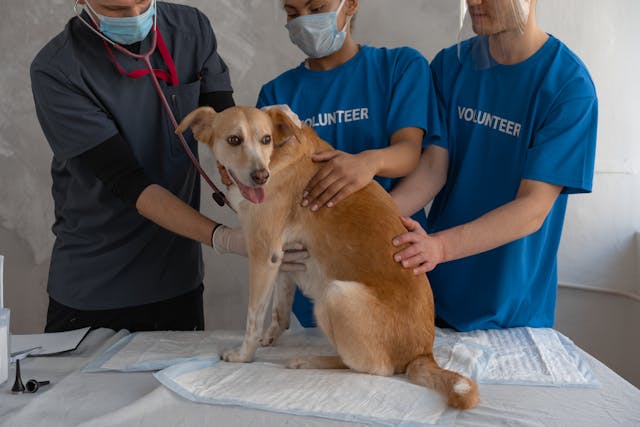It can be awfully distressing when your dog eats something that’s not good for them, or if your cat becomes listless. Unless it’s an obvious emergency where you need to rush off to the veterinary clinic, take a few moments to calmly assess the situation and see what needs to be done.
There may be a few steps you can take at home to relieve their suffering by applying basic first aid principles. Here’s what every animal owner should know.
Take a first aid course
Start by taking a first course designed specifically for animals. If you’ve already received your general first aid certificate, you’ll be somewhat ahead of the game in that many of the same principles will apply to stabilize your pet and prevent further injury. However, it’s advisable to sign up for proper training in animal care. The American Red Cross offers a dog and cat first aid course online, or you may find one offered through a local animal hospital.
Build a first aid kit
Put together a simple first aid kit for home use that, ideally, you can also pack up and take with you when travelling with your pet. Here’s a list of what to include:
- Emergency phone numbers – in addition to your veterinarian, have the contact information for a 24-hour emergency vet and animal poison control
- Medical records for your pet covering immunization and current medications
- An animal digital thermometer
- A spare collar, leash, and a muzzle
- Clean towels and rags
- A roll of gauze, adhesive tape and nonstick bandages
- Scissors and tweezers
- Disposable gloves
- A small flashlight and a magnifying glass
- Eye dropper or syringe
- Lubricating jelly, activated charcoal, corn syrup, and hydrogen peroxide
- Liquid dish soap and a saline solution
Having these tools ready will help you handle any emergencies with confidence until you can establish whether your beloved pet needs expert medical attention.
In the event of illness or injury
If you dog or cat becomes sick or hurts themselves, here are the steps to take.
- Assess the situation – Take a look around to determine if there are other dangers that need to be dealt with to avoid further harm. For instance, perhaps your dog has cut their paw on something in the yard and is limping across the grass. Look to see what may have done the damage and ensure that your pooch is not walking into more trouble. The culprit could be a piece of broken glass lying hidden in the grass.
- Protect yourself and others – If your dog is in pain, they may become uncharacteristically aggressive. This is the reason to use a soft muzzle to prevent any bites while you have a closer look at their injuries. Take note that if an animal is vomiting, a muzzle shouldn’t be worn. Also be sure to ask anyone else in the vicinity to stay back and give you and your pet lots of room. Have someone remove or restrain any other pets to keep them from investigating and causing other issues.
- Keep your pet still and secure – Take a few deep breaths to calm yourself and speak gently to your cat or dog. This is an upsetting time and it’s important for you to do all that you can to help your pet stay still and quiet while you care for their immediate needs and decide the next steps. It could be that they have a broken bone, for example, and movement will cause them additional pain. Unless they can’t be moved, you might consider taking them to a more private part of the house.
- Ensure the animal is warm and comfortable – When an injury or illness occurs, keep your canine or feline as comfortable as possible. Wrap them loosely in a blanket to help them stay warm. Using a blanket will help you to keep them in one place while you administer care. It will also encourage them to settle down a bit if they’re scared.
When to see a veterinarian
Once you have stabilized your pet as much as possible and determined the problem as best you can, you’ll need to decide if a visit to the vet or animal hospital is warranted. If your pet is experiencing any of the following symptoms, you should seek veterinary care as quickly as possible. Watch out for:
- difficulty breathing
- extreme lethargy
- excessively drinking water
- continuous vomiting
- loss of consciousness
- no appetite for longer than a day
- refusing water
- seizures
- severe diarrhea
- unable to urinate
- unresponsive
- for cats, any hiding behavior
In closing
Remember, a little preventative care can go a long way toward keeping your animal companion safe and healthy. However, if illness or injury does strike, being well prepared with some basic first aid skills is invaluable.

